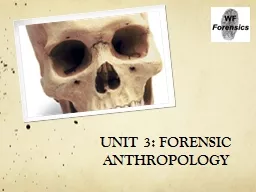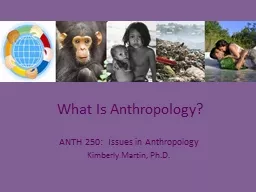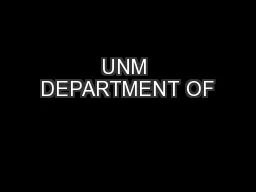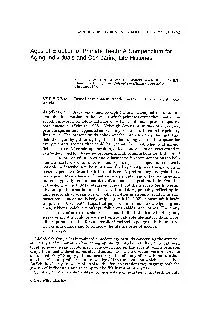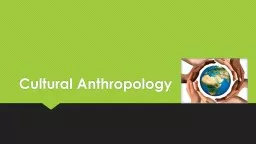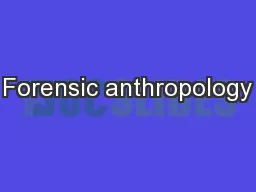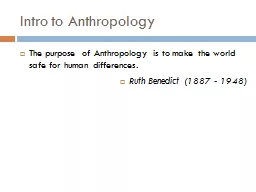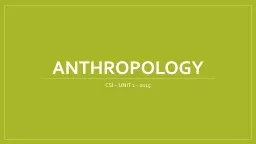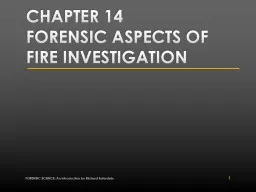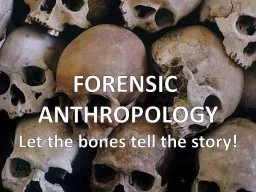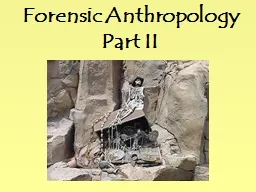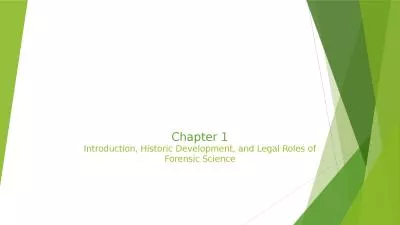PPT-UNIT 3: FORENSIC ANTHROPOLOGY
Author : faustina-dinatale | Published Date : 2016-09-13
Identifying Bones What is Forensic Anthropology The field of study that deals with the analysis of human skeletal remains resulting from unexplained deaths Development
Presentation Embed Code
Download Presentation
Download Presentation The PPT/PDF document "UNIT 3: FORENSIC ANTHROPOLOGY" is the property of its rightful owner. Permission is granted to download and print the materials on this website for personal, non-commercial use only, and to display it on your personal computer provided you do not modify the materials and that you retain all copyright notices contained in the materials. By downloading content from our website, you accept the terms of this agreement.
UNIT 3: FORENSIC ANTHROPOLOGY: Transcript
Identifying Bones What is Forensic Anthropology The field of study that deals with the analysis of human skeletal remains resulting from unexplained deaths Development of Bone Bones begin as cartilage then harden to form bone ossification. ANTH 221: Peoples and Cultures of Mexico. Kimberly Martin, Ph.D.. What is Anthropology?. DEFINITION. Anthropology is the holistic, synthetic, multidisciplinary study of human beings.. KEY COMPONENTS. ANTH 250: Issues in Anthropology. Kimberly Martin, Ph.D.. What is Anthropology?. DEFINITION. Anthropology is the holistic, synthetic, multidisciplinary study of human beings.. KEY COMPONENTS. 1. Anthropology seeks and uses all information about both individual humans and groups of humans regardless of time, geographic location, culture or types of evidence.. 1 ANTHROPOLOGY Undergraduate Handbook Anthropology Concentration Archaeology, Ethnology, Evolutionary Anthropology & General Anthropology 2 Contents The Department of Anthro pology ................... PHYSICAL ANTHROPOLOGY ANTHROPOLOGY 37, 1994 55 - 50- 45 - - 40- APPROXIMATE ABES OF SOME LIFE PERIODS PRENATAL PERIOD - INFANTILE PERIOD 10 Firrt pmnant teebh-XX% JUVENILE PERIOD to last permand teeth What is Culture??. List . three words . that you associate with culture.. . Identify . two question. s that you have about culture.. . Create . one metaphor . or simile for culture (. eg. . “Culture is like …”).. Forensic anthropology is that branch of applied physical anthropology concerned with the identification of human remains and associated skeletal trauma related to manner of death in a legal context (. The purpose of Anthropology is to make the world safe for human differences.. Ruth Benedict (1887 - 1948). . Digging for Meaning? Not Always.. . . A common misconception is that anthropologists only deal with digging into the past (this is actually archaeology). . What is Forensic Science?. …the application of science to those criminal and civil laws that are enforced by police agencies in a criminal justice system.. Forensic Science is…. Applied Science. Often called “criminalistics”. Definition of Anthropology. Greek for . study of humans. How humans are affected by social, environmental, and biological factors. Four sub-branches. Biological/Physical Anthropology: deals with evolution & behavior. Chapter 14 FORENSIC ASPECTS OF FIRE INVESTIGATION FORENSIC SCIENCE: An Introduction by Richard Saferstein 1 Introduction Arson investigations often present complex and difficult circumstances to study due (SATU) Our Location: The SATU unit is located in the Ash Unit on the 2 nd floor (Level C) of the Regional Hospital Mullingar. Our Services: All male and female patients age 14 and older who have biological profile. diaphysis. epiphysis. forensic anthropology. growth plate (epiphyseal plate). CHAPTER 14 VOCABULARY. joints. ossification. osteoporosis. skeletal trauma analysis. Anthropology – the study of the origin, behavior, social, cultural, and physical development of humans. Forensic Anthropology. Anthropology/osteology. Odontology. Entomology. Botany. Forensic Anthropology. . Hic locus est ubi mortui viveuntes docent. .. This is the place where the dead teach the living.. CHE 113. . 2. Learning Goals and Objectives. Today, the role of science in the courtroom is undisputed. We rely upon the scientific analysis and interpretation of key evidence to both exonerate and convict. But this hasn’t always been true in history. In this chapter an introduction to the role that forensic science has and does play in criminal justice is presented. Also, the legal underpinnings of the admissibility, use, and limitations of scientific evidence and testimony are explored. In this chapter, you will need to understand the following concepts:.
Download Document
Here is the link to download the presentation.
"UNIT 3: FORENSIC ANTHROPOLOGY"The content belongs to its owner. You may download and print it for personal use, without modification, and keep all copyright notices. By downloading, you agree to these terms.
Related Documents

